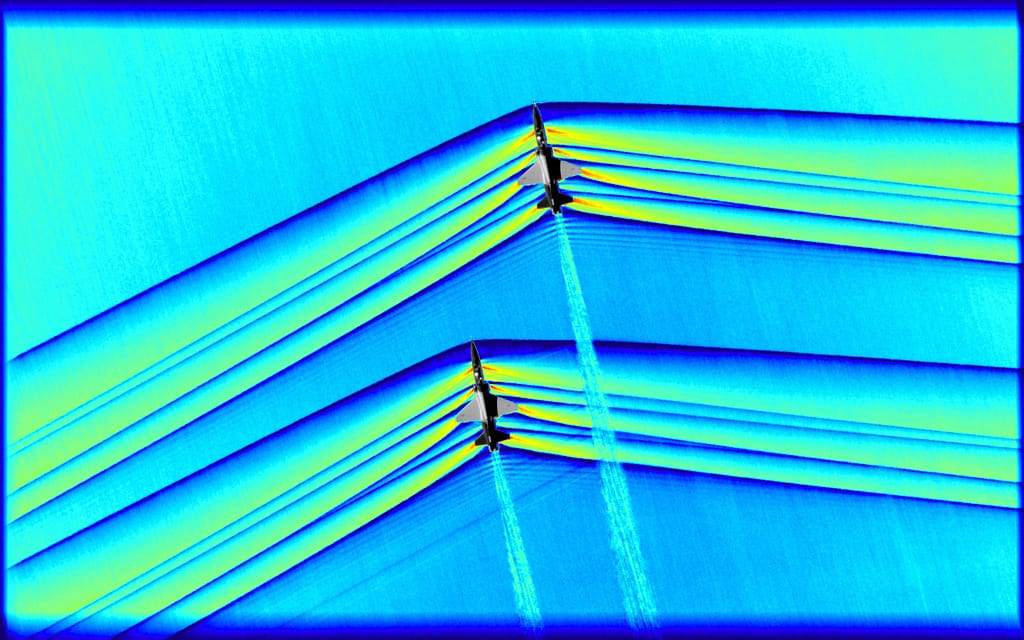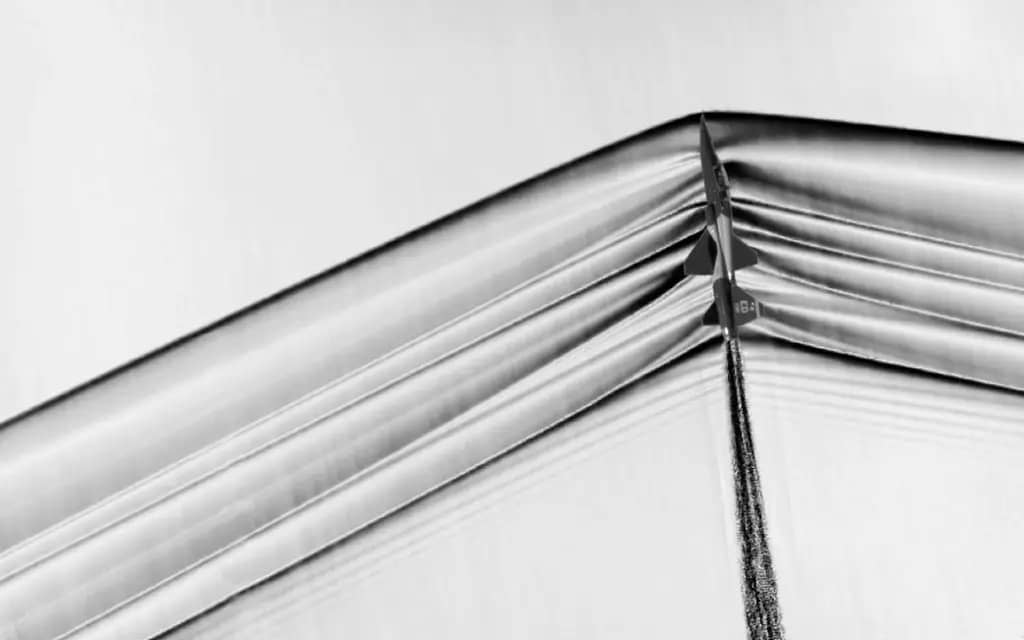To start with: What is the Sound Barrier?
The “sound barrier” refers to the point at which an object travels at the speed of sound, also known as Mach 1. Sound travels as pressure waves through a medium like air, and its speed depends on factors like temperature and altitude. At sea level, the speed of sound is roughly 1,225 kilometers per hour (761 miles per hour). When an object approaches this speed, it encounters a dramatic increase in aerodynamic drag and turbulence—this phenomenon was once thought to be an impenetrable “barrier.”
Breaking the Sound Barrier – and making the Shockwaves visible

NASA employed schlieren photography to capture the groundbreaking air-to-air images showcasing the interaction of shockwaves generated by two supersonic aircraft flying in close formation. The image features two T-38 jets from the U.S. Air Force Test Pilot School, flying roughly 30 feet apart at speeds exceeding the sound barrier. As they cut through the air, their shockwaves—responsible for the familiar sonic booms heard on the ground—were visually recorded in stunning detail. Originally monochromatic, the image was later colorized to enhance its clarity and impact. This remarkable snapshot was part of a supersonic flight series aimed at deepening our understanding of how shockwaves interact both with the exhaust plumes of aircraft and with one another.
When an aircraft accelerates to Mach 1, it compresses air in front of it, creating a shock wave. This leads to the distinctive “sonic boom” heard when the sound barrier is broken. Pilots report that, from their perspective, the transition itself is smooth—they simply fly faster. However, reaching that speed requires advanced engineering to deal with the extreme forces and potential instability.
The first confirmed manned supersonic flight was on October 14, 1947, when Chuck Yeager piloted the Bell X-1 rocket plane at Mach 1.06. This historic achievement proved that the sound barrier could indeed be broken.
Supersonic Flight
Supersonic flight occurs when an aircraft travels faster than the speed of sound, typically at Mach 1 to Mach 5. Aircraft designed for this purpose, like the Concorde or military jets such as the F-22 Raptor, face unique challenges:
- Shockwaves: As an aircraft flies supersonically, shockwaves form around it, affecting aerodynamics and creating drag.
- Heat: Friction with air molecules generates intense heat, necessitating special materials to withstand high temperatures.
- Efficiency: Supersonic speeds consume immense amounts of fuel, which is why supersonic airliners were eventually retired due to cost concerns.
Supersonic flight allows for groundbreaking advancements, from faster travel to military capabilities. Engineers continue to innovate with the hope of developing economically viable, quieter supersonic commercial jets.
To truly push the limits, we even have hypersonic flight (above Mach 5)—but that’s a whole other story!

…and because those photos are so fascinating, here is another one! Well done, NASA!
How does Schlieren Photography work?
Schlieren photography is a fascinating technique used to visualize changes in the density of transparent fluids like air. These density changes are often caused by variations in pressure, temperature, or shockwaves, such as those created by objects moving at supersonic speeds. Here’s how it works:
Key Principles
- Light Refraction: When light passes through a medium with varying density, it bends (refracts) because the speed of light changes slightly depending on the medium’s density.
- Optical Setup: Schlieren systems use a point light source, mirrors, and lenses to make these tiny changes in the light’s direction visible.
How it Works
- Light Source: A bright point source, like a small LED or laser, emits light that passes through a transparent medium.
- Mirror or Lens: A concave mirror or lens focuses the light into parallel beams, which then travel through the area of interest—such as the air around a shockwave.
- Density Disturbances: If there are changes in air density (e.g., due to a shockwave), the light passing through those areas will bend slightly.
- Knife Edge or Filter: At the focal point, a small obstruction (such as a knife edge) blocks part of the light. This enhances the differences in light intensity, making the refracted light stand out.
- Resulting Image: A camera captures the distorted light pattern, revealing the density gradients in the medium. These gradients appear as light and dark regions, showcasing phenomena like shockwaves or heat flow.

And here one last one. Hell, NASA, you rock!
Applications
Schlieren photography is widely used in:
- Aerodynamics: To study shockwaves, airflow, and heat plumes around high-speed aircraft or rockets.
- Engineering: For visualizing heat and fluid flow in research and development.
- Science and Medicine: To observe gas dynamics, such as the movement of heated air around objects.
The result? Stunning visualizations that reveal the invisible dynamics of air and fluids. It’s like giving eyes to phenomena we’d otherwise never see! Wait, did you say never?
…just sayin’
MiGFlug managed to show the moment when the MiG-29 broke the sound barrier during a fighter jet passenger flight? Without Schlieren photography, but normal video cameras! Look carefully, can you see it?

Neueste Kommentare